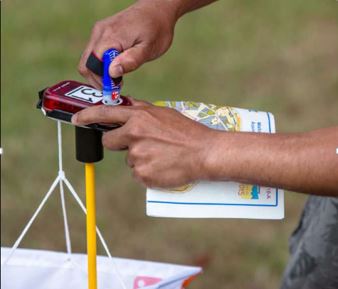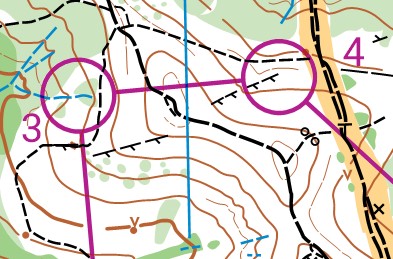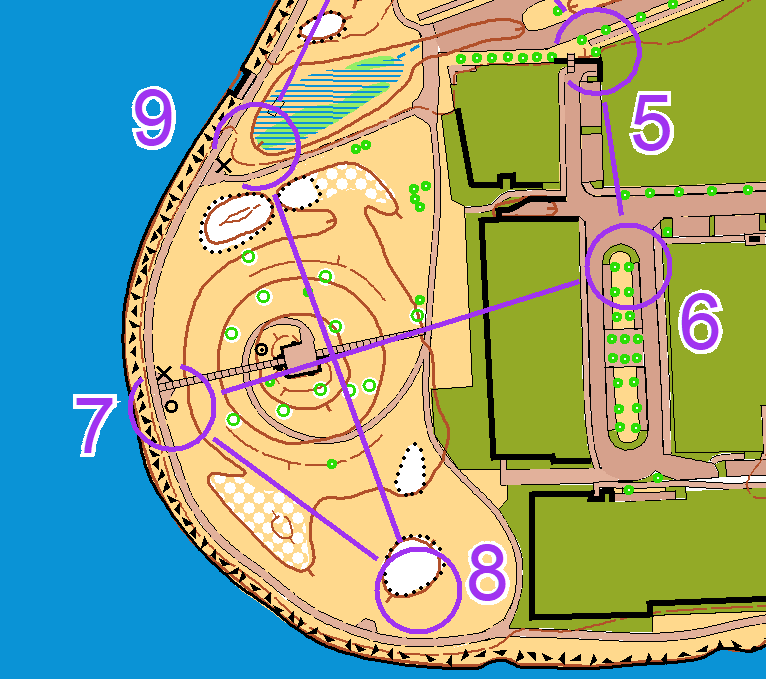What is Orienteering?
Orienteering is a competitive or non-competitive recreational activity in which participants use a detailed topographic map, and usually a compass, to navigate between checkpoints (known as “controls”) on an unfamiliar course in bush terrain, parkland or urban areas.
Fast running (or riding) alone does not make you a winner - you must also decide the best route to the next control and then to navigate to it without losing time.
If you like a mental and physical challenge while exploring the outdoors, orienteering is the sport for you!
Watch the short introduction to Orienteering videos - "Orienteering - the adventure sport for all ages" and "Orienteering in Australia" .



How do I do a course?
Bush and Urban courses are generally a "line course" where you must visit the controls shown on the map in numerical order, aiming to complete the course in the shortest possible time. Our Street-O & Mountain Bike events are mostly "score courses" where you choose which controls to visit to get the highest score within a set time limit.
On most courses orange and white markers ("flags") are placed at each control location. Once the competitor has chosen their route to a control and successfully used their map & compass to navigate to it, and it matches the "control description", they register their visit on a small electronic timing device - a SPORTident card ("SI stick"). Newcastle's Street events and summer Mountain Bike Orienteering use a smartphone GPS app called MapRun, instead of SPORTident, to register the competitor's visit to each control location.
Where are events held?
The club hold events on mapped areas of bush, parkland and urban areas within the Newcastle, Lake Macquarie, Maitland, Cessnock, Port Stephens and Singleton local government areas.



When are events held?
Winter Bush events are generally held on Sunday mornings roughly fortnightly between late March and early October.
In summer daylight savings the club holds Wednesday afternoon events with a weekly "Summer Street Series" using the MapRun app and simplified maps, followed by urban parkland events (“UFO Series”) in March/April.
The club also runs summer Mountain Bike Orienteering events ("BOSS" - Bike Orienteering Summer Series).
You can TRY ORIENTEERING ANYTIME FOR FREE by visiting one of our local Permanent Courses at Blue Gum Hills Regional Park Minmi and at Brickworks Park Wallsend after printing your own map. There is also a permanent course at the Hunter Wetlands Centre (admission fees apply).
What time do events start?
Starts are generally staggered (similar to a time trial or car rally), with competitors on each course starting at set intervals (usually 2 minutes apart).
At winter Sunday bush events participants can start anytime between 9:30am and 11:30am.
Summer Wednesday events have a 5:00pm to 6:30pm start window for Street-O and a 4:45pm to 6:15pm window for Urban Series events.
Summer mountain bike orienteering starts are early Sunday mornings.
Newcomers should arrive earlier rather than later as you will need some instruction before commencing.
How much does it cost?
For current NEWCASTLE CLUB EVENT ENTRY FEES click here.
Many events have reduced entry fees for "first-timers" who have never tried orienteering before.
Do I need to be a member? How do I enter?
Non-members are welcome at all events and you can generally turn up and enter on the day, however, pre-entry is preferred.
Pre-entry online is via Eventor. To enter online non-members need to register as a Casual Member (free) on Eventor - click here to see how.
Who orienteers? Can we participate as a group?
Orienteering attracts a mixture of all age groups and is great family sport as everyone can participate at their own level and at the one venue. Juniors generally need to be about 8-10 years old to undertake a course by themselves and there is no upper age limit - we have 80+ year olds regularly competing. (Note - for safety at Street Orienteering events children under 14 need to be accompanied by someone older).
We have many participants that do their course in pairs or as a team or family group. When you gain more experience you will probably prefer the challenge of navigating and completing the course by yourself.
How competitive is it?
You can amble around a course and enjoy the surroundings, compete seriously by navigating as fast as you can, or anything in between. It's up to you how competetive you make it (just make sure you return before the "Course Closure" time!).
Our local event series have competition classes for all levels and for keen, competitive orienteers there are opportunities to represent the club, state and nation at the championship level.
How difficult is it?
Bush orienteering courses have four navigation difficulty levels. Participants select which level they wish to do depending on their experience, fitness and navigational ability.
- Very Easy: Simple navigation for juniors or total beginners. All controls are on tracks or along fences or other easy to follow linear features and are readily visible when nearby.
-
Easy: Basic navigation. Controls are placed close to tracks, fences, watercourses or other easily followed linear feature. There may be options to "cut across" through the bush.
-
Moderate: Intermediate navigation requiring better map-reading skills. Controls mostly located away from tracks requiring cross-country navigation. Route choice options will require some decision-making.
-
Hard: Challenging navigation requiring advanced map reading skills. Controls require cross-country navigation, may be isolated "point features" or in complex areas, and may not be visible from the line of approach. Wider choice of routes means greater decision-making.
Street, Urban and MTBO events are mostly at an easy navigational level and generally suitable for most beginners. MTBO events require riders to be competent in riding bush tracks and trails.
How long are the courses?
Distances tend to increase the harder you go up the navigational scale and will vary depending on the terrain.
Typical distances* for Newcastle bush orienteering events are:
- Very Easy 1.5-2.5 km
- Easy 2.0-3.0 km
- Moderate Short 2.0-3.0 km
- Moderate Long 3.5-4.5 km
- Hard Short 3.0-4.0 km
- Hard Medium 4.0-6.0 km
-
Hard Long 6.0-8.0 km
* Note - the stated course length is measured as the straight line distance between the controls. On most courses you will travel further depending on which route you choose.
Urban series events have two courses of around 4-5km and 2-2.5km plus a very easy mini course of around 1km for juniors or novices.
Street-O events are "score" events with a 45 minute time limit where you chose a route to visit as many controls as you can.
BOSS mountain bike events have a 75 minute time limit.
How long will it take me?
Typical times taken for bush courses are between 40 and 90 minutes but can vary greatly. An experience junior running a 1.5 km Very Easy course could complete it in as little as 15 minutes while someone walking around a longer Hard course can take over 2 hours.
Urban series courses take around 25 to 60 minutes to complete.
Street-O and BOSS events have time limits of 45 minutes & 75 minutes respectively.
Important to remember is that you must always report back in by the advertised "Course Closure" time even if you have not completed your course.
Will I get lost?
" Orienteers never get lost, they just get navigationally embarassed! ". Whilst every orienteer occasionally has trouble locating a control, if you are on a course that suits your navigational ability and level of fitness you will be able to "relocate" and get back on track. At most local events you will generally never be too far from a road, large recognisable feature or "civilisation". The club has strict safety protocols and procedures which aim to ensure competitors can't stray too far off course, and for locating competitors who may be overdue on their course.
Is coaching available?
At every event there will be experienced club members available and happy to provide help and advice, both before and after you undertake your course. The club holds occasional training events throughout the year to assist people improve their navigation with map and compass and orienteering skills.
The website Coaching Page contains a wealth of material focussing on bush orienteering skills & techniques.
What should I wear/bring?
Comfortable walking or running shoes with good grip are recommended. For bush events a tee shirt and shorts are fine for Very Easy or Easy courses. Loose trousers, tights or shorts with long socks or gaiters are recommended for leg protection on Moderate or Hard courses that venture off the tracks. Normal running/walking gear is fine for Street and Urban events.
Bring your water bottle for hydrating before and after. If you have a compass you can bring it but don't buy one without advice as there are models specifically for orienteering.
For Street and BOSS mountain bike events you will need a smartphone loaded with the MapRun app.
MTBO requires a bike in good order, helmet, water bottle and ideally a handle-bar mounted mapboard (available to borrow/hire).
Where do I buy a map?
Orienteering maps are very detailed and specifically made by and owned exclusively by the individual clubs. They are provided at events as part of your entry and cannot be obtained anywhere else (other than the online maps for our free Permanent Courses).
What isn't permitted?
Dogs, smoking and fires are prohibited from ALL parking, assembly and competition areas.
Are events cancelled due to bad weather?
Scheduled events would only be only cancelled in the rare event of a bushfire threat or other extreme weather conditions, or access issues.
Is the sport dangerous? Am I insured?
There are inherent dangers for anyone navigating in a natural environment, but serious injuries are rare. While the club has public indemnity insurance, it does not cover you for personal injury.
>Risk Notice: Competing in an orienteering event is subject to risks. These include death, serious injury or illness due to: rough terrain and obstacles; overexertion; heat, cold or other adverse weather conditions; plant and animal life; and accidents with vehicles, other competitors or pedestrians. There are also risks that access to medical, evacuation or search services might be slow; and of damage to, or loss of, your personal property.
What other orienteering events are there?
There are various events most weeks of the year within NSW and Australia offering courses for all ages and abilities and there are annual national and international events open to all competitors. For more info on other bush events click here. All scheduled orienteering events can be found on Eventor.
What are the Rules for Orienteering?
Orienteering NSW "Competitors Rules - Foot Orienteering" can be found here. Of particular note for all competitors are:
- You must report to the finish following completion or abandonment of your course. If you do not report to the finish the organisers will come looking for you!
- Fair play: Except in the case of an accident or being seriously lost, obtaining assistance from other competitors or seeking to obtain assistance from other competitors, or providing assistance to other competitors during a competition is forbidden (shadowing/coaching of juniors/beginners excepted). Competitors who are seriously lost (ie. they do not know how to find the finish) can ask for assistance from another competitor.
- Restricted area & routes - competitors should be familiar with the map symbols for out of bounds/do not enter and uncrossable features, including those specific to Sprint Orienteering maps.
- It is the duty of all competitors to help injured competitors. Injured competitors who need assistance should, if possible, blow a whistle (it is recommended all orienteers carry one) or ‘cooee’ three times periodically.
- Pets must not be taken to events held on private land, in nature reserves/national parks or similar areas where they are prohibited, or as otherwise advised by the organisers. This includes bringing a pet and keeping it secured inside a vehicle or trailer.











